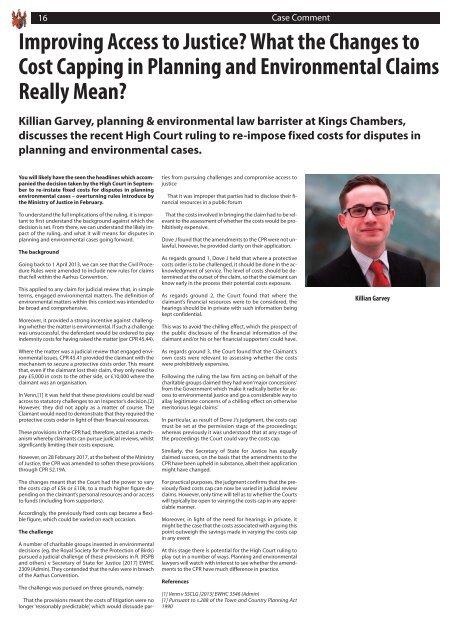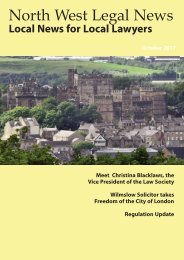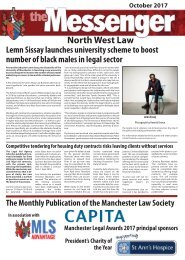Messenger December 2017
You also want an ePaper? Increase the reach of your titles
YUMPU automatically turns print PDFs into web optimized ePapers that Google loves.
16 Case Comment<br />
Improving Access to Justice? What the Changes to<br />
Cost Capping in Planning and Environmental Claims<br />
Really Mean?<br />
Killian Garvey, planning & environmental law barrister at Kings Chambers,<br />
discusses the recent High Court ruling to re-impose fixed costs for disputes in<br />
planning and environmental cases.<br />
You will likely have the seen the headlines which accompanied<br />
the decision taken by the High Court in September<br />
to re-instate fixed costs for disputes in planning<br />
environmental cases – overturning rules introduce by<br />
the Ministry of Justice in February.<br />
To understand the full implications of the ruling, it is important<br />
to first understand the background against which the<br />
decision is set. From there, we can understand the likely impact<br />
of the ruling, and what it will means for disputes in<br />
planning and environmental cases going forward.<br />
The background<br />
Going back to 1 April 2013, we can see that the Civil Procedure<br />
Rules were amended to include new rules for claims<br />
that fell within the Aarhus Convention.<br />
This applied to any claim for judicial review that, in simple<br />
terms, engaged environmental matters. The definition of<br />
environmental matters within this context was intended to<br />
be broad and comprehensive.<br />
Moreover, it provided a strong incentive against challenging<br />
whether the matter is environmental. If such a challenge<br />
was unsuccessful, the defendant would be ordered to pay<br />
indemnity costs for having raised the matter (per CPR 45.44).<br />
Where the matter was a judicial review that engaged environmental<br />
issues, CPR 45.41 provided the claimant with the<br />
mechanism to secure a protective costs order. This meant<br />
that, even if the claimant lost their claim, they only need to<br />
pay £5,000 in costs to the other side, or £10,000 where the<br />
claimant was an organisation.<br />
In Venn,[1] it was held that these provisions could be read<br />
across to statutory challenges to an Inspector’s decision.[2]<br />
However, they did not apply as a matter of course. The<br />
Claimant would need to demonstrate that they required the<br />
protective costs order in light of their financial resources.<br />
These provisions in the CPR had, therefore, acted as a mechanism<br />
whereby claimants can pursue judicial reviews, whilst<br />
significantly limiting their costs exposure.<br />
However, on 28 February <strong>2017</strong>, at the behest of the Ministry<br />
of Justice, the CPR was amended to soften these provisions<br />
through CPR 52.19A.<br />
The changes meant that the Court had the power to vary<br />
the costs cap of £5k or £10k, to a much higher figure depending<br />
on the claimant’s personal resources and or access<br />
to funds (including from supporters).<br />
Accordingly, the previously fixed costs cap became a flexible<br />
figure, which could be varied on each occasion.<br />
The challenge<br />
A number of charitable groups invested in environmental<br />
decisions (eg. the Royal Society for the Protection of Birds)<br />
pursued a judicial challenge of these provisions in R. (RSPB<br />
and others) v Secretary of State for Justice [<strong>2017</strong>] EWHC<br />
2309 (Admin). They contended that the rules were in breach<br />
of the Aarhus Convention.<br />
The challenge was pursued on three grounds, namely:<br />
That the provisions meant the costs of litigation were no<br />
longer ‘reasonably predictable’, which would dissuade parties<br />
from pursuing challenges and compromise access to<br />
justice<br />
That it was improper that parties had to disclose their financial<br />
resources in a public forum<br />
That the costs involved in bringing the claim had to be relevant<br />
to the assessment of whether the costs would be prohibitively<br />
expensive.<br />
Dove J found that the amendments to the CPR were not unlawful,<br />
however, he provided clarity on their application.<br />
As regards ground 1, Dove J held that where a protective<br />
costs order is to be challenged, it should be done in the acknowledgment<br />
of service. The level of costs should be determined<br />
at the outset of the claim, so that the claimant can<br />
know early in the process their potential costs exposure.<br />
As regards ground 2, the Court found that where the<br />
claimant’s financial resources were to be considered, the<br />
hearings should be in private with such information being<br />
kept confidential.<br />
This was to avoid ‘the chilling effect, which the prospect of<br />
the public disclosure of the financial information of the<br />
claimant and/or his or her financial supporters’ could have.<br />
As regards ground 3, the Court found that the Claimant’s<br />
own costs were relevant to assessing whether the costs<br />
were prohibitively expensive.<br />
Following the ruling the law firm acting on behalf of the<br />
charitable groups claimed they had won ‘major concessions’<br />
from the Government which ‘make it radically better for access<br />
to environmental justice and go a considerable way to<br />
allay legitimate concerns of a chilling effect on otherwise<br />
meritorious legal claims.’<br />
In particular, as result of Dove J’s judgment, the costs cap<br />
must be set at the permission stage of the proceedings;<br />
whereas previously it was understood that at any stage of<br />
the proceedings the Court could vary the costs cap.<br />
Similarly, the Secretary of State for Justice has equally<br />
claimed success, on the basis that the amendments to the<br />
CPR have been upheld in substance, albeit their application<br />
might have changed.<br />
For practical purposes, the judgment confirms that the previously<br />
fixed costs cap can now be varied in judicial review<br />
claims. However, only time will tell as to whether the Courts<br />
will typically be open to varying the costs cap in any appreciable<br />
manner.<br />
Moreover, in light of the need for hearings in private, it<br />
might be the case that the costs associated with arguing this<br />
point outweigh the savings made in varying the costs cap<br />
in any event<br />
At this stage there is potential for the High Court ruling to<br />
play out in a number of ways. Planning and environmental<br />
lawyers will watch with interest to see whether the amendments<br />
to the CPR have much difference in practice.<br />
References<br />
[1] Venn v SSCLG [2013] EWHC 3546 (Admin)<br />
[1] Pursuant to s.288 of the Town and Country Planning Act<br />
1990<br />
Killian Garvey
















